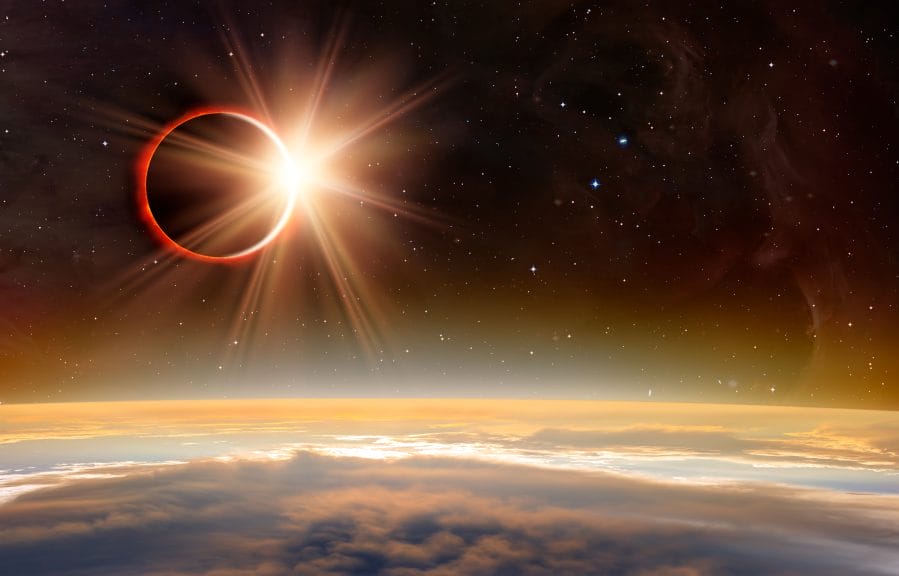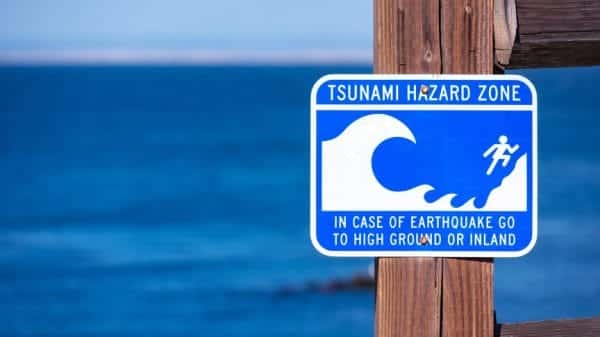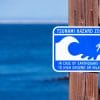- A Total Solar Eclipse will be taking place on Monday, April 8th, 2024 for the first time since 2017.
- Find out the exact time to view the event in its totality and where you will be able to view it.
- Learn what a total solar eclipse is and its path of totality. Also, the viewing of Jupiter, Venus, and the “Devil Comet”
- Understand what safety wear to have on hand as well as the difference this eclipse has from the one in 2017. Spoiler: it’s a better experience this year than before!
A solar eclipse happens when the moon passes between the sun and the earth. As the moon blocks the sun’s light, it casts a shadow on part of the Earth. The moon’s shadow creates a path as the earth rotates. This is the path of totality. In its totality, the moon completely blocks the sun’s light for a few minutes. It gets so dark that it looks like nighttime with a full moon!
This event will be occurring on Monday, April 8th, 2024. On the east coast, it will begin around 2 pm as the moon’s orbit travels in between the sun and the earth. Within the path of totality, the total eclipse phase will last around 3:15pm to 3:20pm.
Where to View the 2024 Eclipse
April’s eclipse will cross through North America. It will be seen in parts of Mexico, the United States, and Canada. The solar eclipse will begin in Mexico’s Pacific Coast at around 11:07 am PDT. The eclipse will then leave continental North America on the Atlantic Coast of Newfoundland Canada, at approximately 5:16 pm NPT.
The largest duration of totality will be 4 minutes and 28 seconds and this will occur near Torreon, Mexico. Most places along the path shown on the map will see a duration of totality between 3.5 to 4 minutes.
April’s eclipse will enter the U.S. in Texas, and then move on to Oklahoma, Arkansas, Missouri, Illinois, Kentucky, and Indiana. Also, Ohio, Pennsylvania, New York, Vermont, New Hampshire, and Maine. Small parts of Tennessee and Michigan will also experience the total solar eclipse. According to Time magazine, a lot of this eclipse viewing ability depends on the weather at the time of totality. A cloudy day could prevent visitors from seeing the show altogether. Below is a total solar eclipse map for the USA provided by National Eclipse.
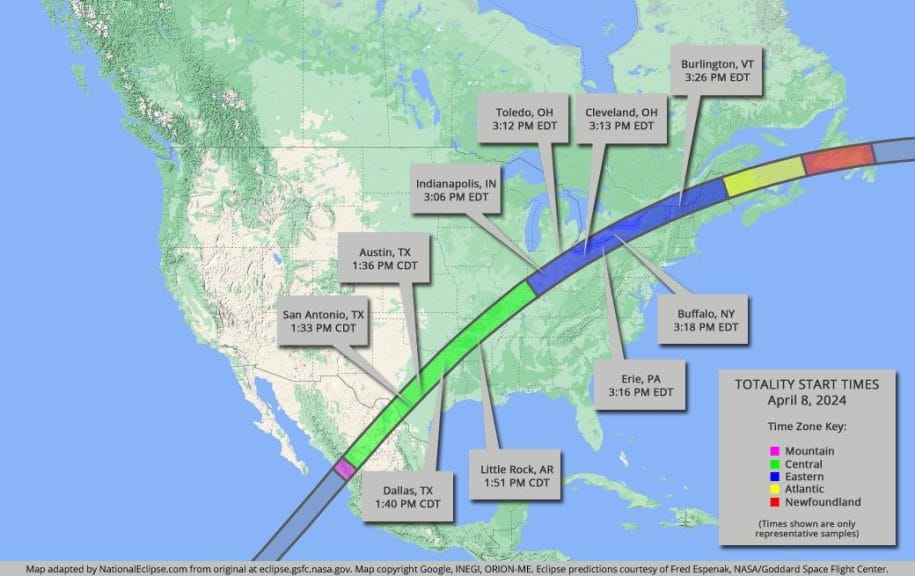
Venus, Jupiter, and the “Devil’s Comet”
According to Greenville News, you will be able to see other parts of outer space with the solar eclipse. This includes Venus, Jupiter, and the “Devil’s Comet.” Venus is the 3rd brightest object in the sky after the sun and the moon that shows itself. Venus lies 15 degrees west-southwest of the eclipse. It will show itself in the sky at its brightest point 10 minutes before the totality of the eclipse. Because of its brightness, you should be cautious when searching for the planet through binoculars.
You will also be able to see Jupiter which comes in second to Venus on the other side of the sun. Its magnitude at 2.1 will be on the other side of the sun from the “morning star” 30 degrees to the east-northeast. Venus will be 5 and 1/4 times brighter than Jupiter. The large planet will be visible at the totality of the eclipse as well as a couple of minutes before.
You may also be lucky enough to catch a glimpse of the “Devil’s Comet,” also known as Comet Pons/Brooks, which passes the earth once every seventy-one years. Comets don’t always perform as expected by astronomers, but if you can catch it make sure that you are wearing the right protective glasses for the entire show. If the comet is bright enough for the human eye to see, binoculars can view the event during totality at six degrees to the right of Jupiter. Below is a map detailing the layout you can expect in the sky.
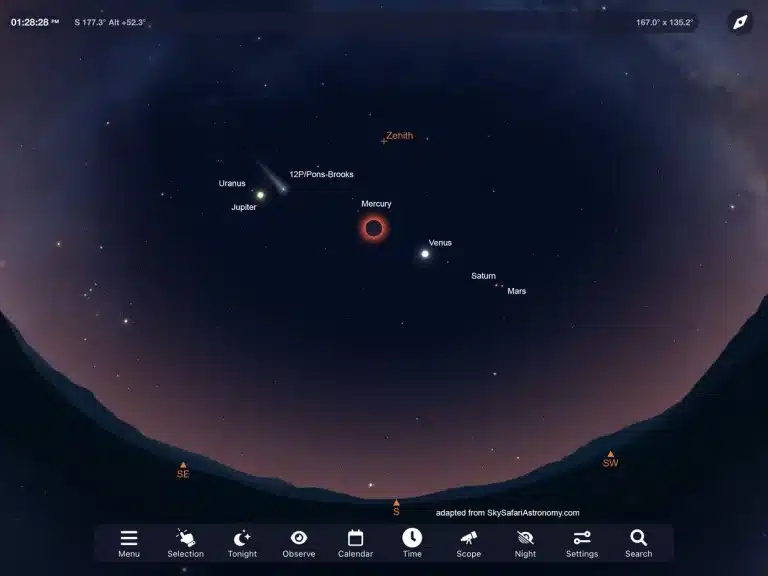
Safely Viewing a Total Solar Eclipse
Never look at the sun through binoculars, photo cameras, telescopes, or any optical device without using eclipse glasses or handheld filters. The sun will burn through these types of technology and damage your eyes.
Solar Retinopathy is a condition where light-sensitive cells in the retina are damaged from viewing the sun or solar system with the naked eye. Viewing can lead to permanent vision loss that is caused by the sun’s extreme light. Symptoms can include blurry vision, light sensitivity, dark spots or “blind spots” in your central vision, altered color perception (or difficulty in telling the difference between colors), or a sensation of pressure in the eye.
Solar Retinopathy may not appear immediately after you are exposed to the sun. It develops gradually over hours or days. Symptoms may resolve on their own, but in the worst cases, they may continue or worsen over time.
There are special filters that meet an International standard, labeled with the ISO 12312-2 certification. They must have the manufacturer’s name and address printed somewhere on the product, and must not be older than three years or have scratches on the lenses. Instagram commenter @honeyyy_bb_ asked NASA on their post about the Solar Eclipse “Where do we get the glasses from?” NASA replied, “Check out go.nasa.gov/Eclipse2024Safety for more information on safe solar viewing and eclipse glasses.” Here is an example of ISO 12312-2 glasses that you can buy on Amazon for your viewing experience.
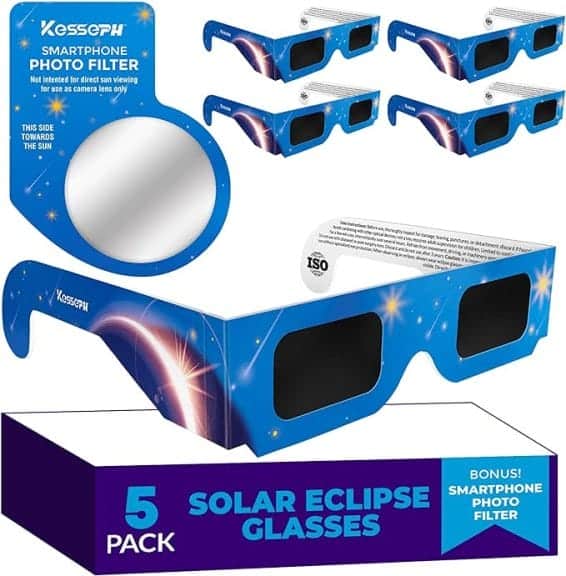
2024 Eclipse Versus 2017 Eclipse
According to NASA, this April’s eclipse is expected to be better in several ways for the viewing of many more people. In 2017 solar eclipse, the moon was farther from Earth causing the path to be a skinner. The path range was 62 to 71 miles wide, but during April’s eclipse, it will range in North America from 108 to 122 miles wide covering more ground for viewers.
The 2024 eclipse will pass over more cities. This will make it easier for more people to see when the sun reaches its full coverage. 31.6 million people will be in its path of totality compared to 12 million in 2017. This means that 150 million more viewers will be able to see the solar eclipse that live within 200 miles of the path of totality.
In April’s eclipse, the totality will last longer than in 2017. The longest reported time of totality in 2017 was neat Carbondale, Illinois at 2 minutes and 42 seconds. During the 2024 eclipse, you will be able to view the solar eclipse for a lot longer from anywhere you’re located, at 4 minutes and 25 seconds.
There were many positive comments on NASA’s Instagram post. Instagram user @michelerubenstein commented, “Can’t wait, but I’m sure it will be cloudy that day in NY!” Other Instagram users such as @indianapolismotorspeedway were excited for their viewing event. “Can’t wait for everyone to watch the #SolarEclipse from the Racing Capital of the World!” Overall, the 2024 solar eclipse will be a better viewing experience than 2017, allowing you to view the eclipse for a longer period, see other planets, and have the possibility of seeing a once-in-a-lifetime comet.


